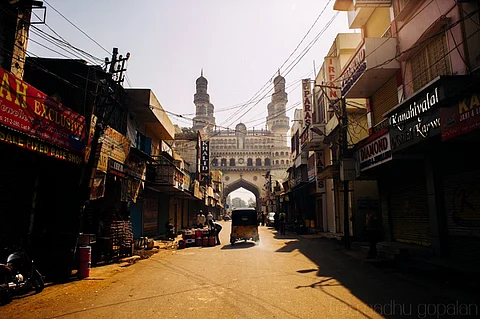

On October 9 this year, Hyderabad would complete a milestone. It will be 425 years old. It was on this day in 1591 that the Charminar was built, the first building to come up in the new city of Hyderabad that Sultan Mohammed Quli Qutb Shah had planned. Since 1100, Golconda was the seat of power in the Deccan plateau, first with the Kakatiyas, then ceded to the Bahamanis and finally the Qutb Shahi dynasty. With Golconda facing infrastructure issues, this was the new king's plan to move it away from the old fort.
Most believe that the Charminar was built to commemorate the eradication of a plague, that was prevalent at that time. Historian Mohammed Safiullah is not entirely in agreement pointing out that such outbreak of diseases was commonplace in those times and believes that the Charminar was constructed as the epicentre of the new city of Hyderabad.
But while these two remain the most credible theories around the construction of this exquisite monument, several others abound as well. Each one sounds as possible as the other and it is a delight for anyone with interest in history, to listen to them.
Safiullah points out that October 9, 1591 was the first day of the 1000th year since Islam came into existence and believes that it is quite likely that Charminar was built also to commemorate the occasion.
In terms of structure, the Charminar is modelled as a memorial to the martyrs of Karbala. In fact, if you see the Charminar from the Lal Darwaza side, it has a coffin in the elevation. It is also a Shia structure in the manner of its design.
Image courtesy:Madhumita Gopalan
Those with a more imaginative mind believe that the house of Bhagmati, the lover of king Muhammed Quli Qutb Shah, was located in the area which is why he planned to build the Charminar at this location. Another unverified tale goes that this is the place where he first saw Bhagmati. But a look at the years preceding 1589 indicate that the move to shift away from Golconda had begun in 1578 itself under the previous ruler when Purana Pul was constructed across the Musi river. Hussainsagar lake was already an entity built in 1562.
However, the fact that Hyderabad was named after Hyder Mahal, the name Bhagmati took after conversion to Islam and married the king Quli Qutb Shah, is quite possible.
Work on the Charminar started in 1589 and it took two years to complete at a cost of Rs 9 lakh. In terms of the currency of those times, it cost 2 lakh Huns (gold coin), with the value of one Hun Rs 4.50. It was followed by the construction of the Badshahi Ashurkhana (a mourning place for Shias during Moharram) in 1593 and Darulshifa (hospital) in 1595. But the first evidence of the shift of the seat of power came in 1603 when the first coins with the inscription of `Hyderabad' were minted. Earlier coins were inscribed with `Golkonda' seal.
The Charminar was designed by an Iranian architect, Mir Momin Astrawadi, who had settled in Hyderabad. It weighs 14000 tonnes and it is estimated that the foundation to bear the weight would be at least 30 feet deep. The limestone and mortar structure used no bricks, was struck by lightning in the 1670s and one of its minarets fell. It was then repaired at a cost of Rs 58000.
In 1820, Sikandar Jah spent Rs 2 lakh on giving the Charminar a facelift. The lime and mortar work was ripped apart and relaid to give strength to the structure.
Lover boy king Qutb Shah was also a poet and while laying the foundation of the Charminar, he expressed this wish for the new city, in the form of a couplet. Translated from Dakhini, it says : “Fill this my city with people as, Though hast filled the river with fishes, O Lord.”
The Charminar faced its toughest moment in 1687 when Mughal emperor Aurangzeb attacked Hyderabad and destroyed all the buildings in the kingdom. The tale goes that he wanted to blast the Charminar as well and had placed his cannons in front of the structure for the purpose when someone told him that a mosque exists on top of the monument. That piece of information saved the Charminar for future generations.
In the 1750s, the Charminar and the area around it was occupied by the French Governor. It was in 1884 that the clocks and the barricades made an appearance. The Nizams who ruled Hyderabad later cared for the Charminar, appreciating it as a relic from the Quli Qutb Shahi dynasty.
Even though every side of the Charminar is equal (20 metres long), the interesting part is that the design on every side is different. In contrast to the Charminar that was built in record time, the Mecca Masjid that is a few steps away, took 77 years to complete. It was incidentally finished in 1695 by Aurangzeb after he conquered Hyderabad.
Over the years, the administration has failed to make the area around the Charminar fully pedestrianised. As a result, the monument has suffered from air pollution. As Hyderabad celebrates turning 425, it will hopefully also be a moment to spare a thought for the splendid structure that has withstood time, weather and the might of Aurangzeb.